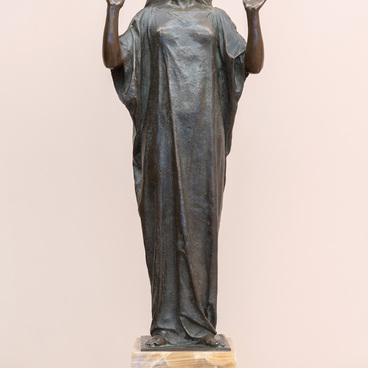The Corner Drawing Room, which was one of Empress Alexandra Feodorovna’s apartments, features a magnificent woolen carpet of almost 100m² with a central radial pattern of griffins, dolphins, masks and cartouches. It is in pale, greenish and dark terracotta tones and has a border on the perimeter.
The carpet was made at the Savonnerie factory in France in the early 19th century and was purchased especially for the Billiard Room (later the Corner Drawing Room) in the east wing of the Alexander Palace. At that time the carpet was spread only during Their Majesties’ stay (from spring to autumn). To protect it from spoiling during breakfasts and luncheons, it was covered with water-resistant sailcloth.
The Savonnerie factory was founded in France in the 17th century on the site of a former soap factory and was named accordingly (French “Savonnerie” means soap factory, from savon — soap). It was located on the right bank of the Seine, on the Chaillot Hill (now the Trocadero district). King Henry IV of France played a crucial role in creating the factory. He ordered to open his own carpet weaving factory, as importing carpets from the East was exorbitantly expensive for the French treasury. Savonnerie carpets adorned the Louvre and Versailles, and were also used as diplomatic gifts and expensive high status presents the king gave to his entourage.
The individual style of the factory was formed under the influence of classical oriental patterns and ornaments, followed by elements of European art of different epochs: luxurious baroque, refined rococo and elegant classicism. The designs of the carpets are full of intricate floral ornaments, compositions of vignettes, bouquets and wreaths; they are decorated with the images of heraldic medallions, zoomorphic motifs. Carpets were made mainly from wool with natural silk. The latter brought out the beauty of the intricately detailed pattern. It took several months to create a sketch. The number of colors and tones used in the production ranged from 200 to 400.
By the late 18th century, the Savonnerie factory was producing not only carpets, but also panels for screens and tapestries. The decline of the factory began during the Great French Revolution. In 1825, the company, experiencing financial difficulties, merged with the Gobelins factory (later the Manufactory of National Furniture), losing the independence of its brand. The Savonnerie products preserved in museums and private collections are undoubtedly unique works of applied art.
The carpet was made at the Savonnerie factory in France in the early 19th century and was purchased especially for the Billiard Room (later the Corner Drawing Room) in the east wing of the Alexander Palace. At that time the carpet was spread only during Their Majesties’ stay (from spring to autumn). To protect it from spoiling during breakfasts and luncheons, it was covered with water-resistant sailcloth.
The Savonnerie factory was founded in France in the 17th century on the site of a former soap factory and was named accordingly (French “Savonnerie” means soap factory, from savon — soap). It was located on the right bank of the Seine, on the Chaillot Hill (now the Trocadero district). King Henry IV of France played a crucial role in creating the factory. He ordered to open his own carpet weaving factory, as importing carpets from the East was exorbitantly expensive for the French treasury. Savonnerie carpets adorned the Louvre and Versailles, and were also used as diplomatic gifts and expensive high status presents the king gave to his entourage.
The individual style of the factory was formed under the influence of classical oriental patterns and ornaments, followed by elements of European art of different epochs: luxurious baroque, refined rococo and elegant classicism. The designs of the carpets are full of intricate floral ornaments, compositions of vignettes, bouquets and wreaths; they are decorated with the images of heraldic medallions, zoomorphic motifs. Carpets were made mainly from wool with natural silk. The latter brought out the beauty of the intricately detailed pattern. It took several months to create a sketch. The number of colors and tones used in the production ranged from 200 to 400.
By the late 18th century, the Savonnerie factory was producing not only carpets, but also panels for screens and tapestries. The decline of the factory began during the Great French Revolution. In 1825, the company, experiencing financial difficulties, merged with the Gobelins factory (later the Manufactory of National Furniture), losing the independence of its brand. The Savonnerie products preserved in museums and private collections are undoubtedly unique works of applied art.




